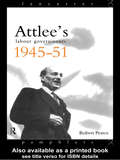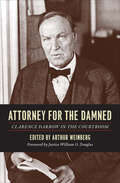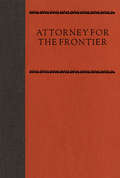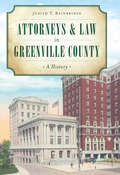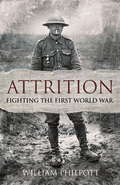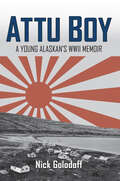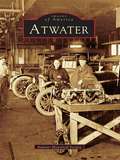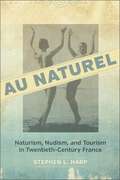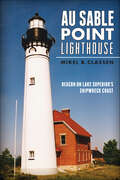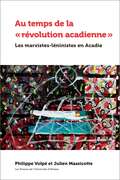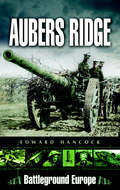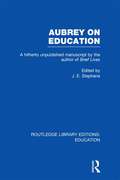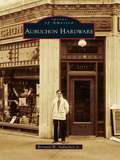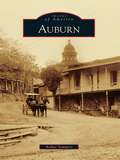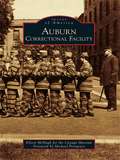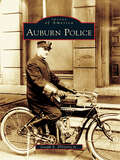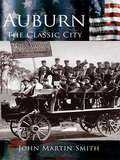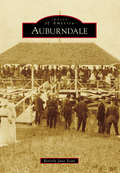- Table View
- List View
Attlee's Labour Governments 1945-51 (Lancaster Pamphlets)
by Robert PearceThe Labour governments of 1945-51 are among the most important and controversial in modern British history, and have been the focus of extensive research over the last fifteen years. In this study, Robert Pearce makes the results of this research available in a concise and accessible form, whilst encouraging students to formulate their own interpretations. He looks at the main political personalities of the period, sets their work in the context of Labour history since 1900, and examines their domestic, foreign and imperial achievements.
Attorney for the Damned: Clarence Darrow in the Courtroom
by Clarence DarrowCourtroom summations by &“one of America&’s greatest lawyers . . . this book is better than an entire college course in Rhetoric&” (Thomas Geoghegan, author of The Secret Lives of Citizens and Only One Thing Can Save Us). A famous defender of the underdog, the oppressed, and the powerless, Clarence Darrow (1857–1938) is one of the true legends of the American legal system. His cases were many and various, but all were marked by his unequivocal sense of justice, as well as his penchant for representing infamous and unpopular clients, such as the Chicago thrill-killers Leopold and Loeb; Ossian Sweet, the African American doctor charged with murder after fighting off a violent, white mob in Detroit; and John T. Scopes, the teacher on trial in the famous Scopes Monkey Trial. Published for the first time in 1957, Attorney for the Damned collects Darrow&’s most influential summations and supplements them with scene-setting explanations and comprehensive notes by Arthur Weinberg. Darrow confronts issues that remain relevant over half a century after his death: First Amendment rights, capital punishment, and the separation of church and state. With an insightful forward by Justice William O. Douglas, this volume serves as a powerful reminder of Darrow&’s relevance today. &“Clarence Darrow [was] perhaps the most effective courtroom opponent of cant, bigotry, and special privilege that our country has produced . . . The ghastly comedy of his deadpan interrogation of William Jennings Bryan on the origin of man in the Scopes case is particularly recommended.&” —The New Yorker &“More illuminating as well as more dramatic than anything that has yet appeared about [Darrow].&” —Herald Tribune Book Review
Attorney for the Frontier: Enos Stutsmon
by Dale Gibson Lee Gibson Cameron HarveyThe purpose of this biography is to bring to public attention the importance of the contributions made by Enos Stutsman, an American, to the history of the province and the Northwest generally. It also attempts to impress and entertain the reader by highlighting Stutsman’s personal qualities.
Attorneys & Law in Greenville County: A History
by Judith T. BainbridgeFor more than two hundred years, lawyers and judges, many of them colorful and powerful personalities, have practiced law and maintained order in Greenville County. In the nineteenth century, Judges Richard Gantt and Waddy Thompson began the tradition of Upstate justice. At the time of the Civil War, Benjamin Perry and his colleagues argued fiercely about secession. Recently, local attorneys and judges, both black and white, have struggled with integration and civil rights issues. History is dotted with legal dynasties; individual practioners like "Miss Jim" Perry and John Bolt Culbertson; and judges, including J. Robert Martin and Frank Eppes, who have played significant roles in Upstate law. Author Judith Bainbridge details the impact and personalities of law and lawyers in Greenville County.
Attracted to the Earl (Imperfect Lords #3)
by Bronwen EvansUnable to read or write, an earl discovers love in the last place he expects to find it—within the embrace of a brilliant woman—in this sexy, irresistible novel from USA Today bestselling author Bronwen Evans. What’s an earl to do? The Earl of Argyle has died suddenly, leaving his brother Guy Neville at a complete loss. The dull-witted second son, as his father used to call him, Guy is now responsible for the estate and his brother’s seat in the House of Lords. Shamed by an inability to read or write, his distress is multiplied by an inquiry from a dyed-in-the-wool bluestocking who wishes to use the Argyle library and study a rare plant on the estate. Guy’s first instinct is to decline her request—until he catches a glimpse of Miss Abigail Pinehurst. How’s a girl to behave? Abigail cares for only one thing: plants. She is unconcerned about how she looks, what she wears, or the impression she makes on men. An orphan who turned to books for solace in a miserly, cruel institution, she now makes her living illustrating the greenery she adores. Lord Argyle, in fact, with his uncanny memory and chiseled features, is the first man to capture her attention—a ridiculous distraction since he is so far above her station. But her unreasonable heart has a mind of its own. Look for the enchanting Disgraced Lords series from Bronwen Evans: A KISS OF LIES | A PROMISE OF MORE | A TOUCH OF PASSION | A WHISPER OF DESIRE | A TASTE OF SEDUCTION | A NIGHT OF FOREVER And don’t miss her novels in the Imperfect Lords series: ADDICTED TO THE DUKE | DRAWN TO THE MARQUESS | ATTRACTED TO THE EARL Includes an excerpt from another Loveswept title.
Attractive Widow: Volume 1 (Volume 1 #1)
by Xian QuanXiaoYuLi Qiqiao had a tough life, but he was blessed with karmic luck. The bridegroom stepped through the door, and a year later produced a wild seed of unknown origin. It was said that the River Deity refused to accept anyone who had not been pushed to a certain point. But the Goddess said. It was not that Hades would not accept it. The heavens would take her in before she was thirty, the earth would cheat her, and men would despise her …
Attractive Widow: Volume 2 (Volume 2 #2)
by Xian QuanXiaoYuLi Qiqiao had a tough life, but he was blessed with karmic luck. The bridegroom stepped through the door, and a year later produced a wild seed of unknown origin. It was said that the River Deity refused to accept anyone who had not been pushed to a certain point. But the Goddess said. It was not that Hades would not accept it. The heavens would take her in before she was thirty, the earth would cheat her, and men would despise her …
Attrition: Fighting the First World War
by William PhilpottThe First World War was too big to be grasped by its participants. In the retelling of their war in the competing memories of leaders and commanders, and the anguished fiction of its combatants, any sense of order and purpose, effort and achievement, was missing. Drawing on the experience of front line soldiers, munitions workers, politicians and those managing the vast economy of industrialised warfare, Attrition explains for the first time why and how this new type of conflict born out of industrial society was fought as it was. It was the first mass war in which the resources of the fully-mobilised societies strained every sinew in a conflict over ideals - and the humblest and highest were all caught up in the national enterprise. In a stunning narrative, this brilliant and necessary reassessment of the whole war cuts behind the myth-making to reveal the determination, organization and ambition on all sides.
Attu Boy: A Young Alaskan's WWII Memoir
by Nick GolodoffIn the quiet of morning, exactly six months after Pearl Harbor, the Japanese touched down on American soil. Landing on the remote Alaska island of Attu, they assailed an entire village, holding the Alaskan villagers for two months and eventually corralling all survivors into a freighter bound for Japan. One of those survivors, Nick Golodoff, became a prisoner of war at just six years old. He was among the dozens of Unangan Attu residents swept away to Hokkaido, and one of only twenty-five to survive. Attu Boy tells Golodoff’s story of these harrowing years as he found both friendship and cruelty at the hands of the Japanese. It offers a rare look at the lives of civilian prisoners and their captors in WWII-era Japan. It also tells of Golodoff’s bittersweet return to a homeland torn apart by occupation and forced internments. Interwoven with other voices from Attu, this richly illustrated memoir is a testament to the struggles, triumphs, and heartbreak of lives disrupted by war.
Atwater
by Atwater Historical SocietyThe town of Atwater was rich in a different kind of treasure than the gold usually sought by people flocking to California in the 1850s. Named for Marshall D. Atwater, a tenant on several of founder John W. Mitchell's 2,000-acre parcels, the community boasted a mineral-rich alluvial soil that made it an extremely productive agricultural area. When the Central Pacific Railroad came through--thanks to lobbying from Mitchell, along with several strips of free land deeded to the railroad--a switch was laid next to Atwater's warehouse. The train switch and the building became known as Atwater Station, and in time, the town itself bore his name.
Au Naturel: Naturism, Nudism, and Tourism in Twentieth-Century France
by Stephen L. HarpEach year in France approximately 1.5 million people practice naturisme or "naturism," an activity more commonly referred to as "nudism." Because of France's unique tolerance for public nudity, the country also hosts hundreds of thousands of nudists from other European nations, an influx that has contributed to the most extensive infrastructure for nude tourism in the world. In Au Naturel, historian Stephen L. Harp explores how the evolution of European tourism encouraged public nudity in France, connecting this cultural shift with important changes in both individual behaviors and collective understandings of the body, morality, and sexuality.Harp's study, the first in-depth historical analysis of nudism in France, challenges widespread assumptions that "sexual liberation" freed people from "repression," a process ostensibly reflected in the growing number of people practicing public nudity. Instead, he contends, naturism gained social acceptance because of the bodily control required to participate in it. New social codes emerged governing appropriate nudist behavior, including where one might look, how to avoid sexual excitation, what to wear when cold, and whether even the most modest displays of affection -- -including hand-holding and pecks on the cheek -- were permissible between couples.Beginning his study in 1927 -- when naturist doctors first advocated nudism in France as part of "air, water, and sun cures" -- Harp focuses on the country's three earliest and largest nudist centers: the Île du Levant in the Var, Montalivet in the Gironde, and the Cap d'Agde in Hérault. These places emerged as thriving tourist destinations, Harp shows, because the municipalities -- by paradoxically reinterpreting inde-cency as a way to foster European tourism to France -- worked to make public nudity more acceptable.Using the French naturist movement as a lens for examining the evolving notions of the body and sexuality in twentieth-century Europe, Harp reveals how local practices served as agents of national change.
Au Revoir Liverpool
by Maureen LeeA gripping Second World War novel, from the bestselling author of NOTHING LASTS FOREVER and THE LEAVING OF LIVERPOOL.Liverpool, 1937. Jessica is married to Bertie, a mean, patronising man who she has stayed with purely for the sake of her two young children. To make up for the love and passion that is missing from her life, she spends the occasional afternoon at the local cinema, lost in romantic films. But when an unexpected glass of champagne is offered to her in a Liverpool hotel, the consequences turn out to be shattering.When Bertie discovers his wife's deceit, he is ruthless in his revenge. He sells their house and disappears with her beloved children, leaving Jessica devastated and alone. Then she is asked to visit Paris and help an old friend and her small daughters return to Liverpool before the onset of the war. But Jessica finds herself stranded in Paris under German occupation. With new friends and a small family to care for, she must find the courage that she never knew she possessed...
Au Sable Point Lighthouse: Beacon on Lake Superior's Shipwreck Coast (Landmarks)
by Mikel B. ClassenSkeleton ship frames surround Au Sable Point, marking a mile-long sandstone reef that reached out into Lake Superior waiting to grab any and all ships that passed by. In an effort to end this tragic loss of lives, the Au Sable Point Lighthouse was constructed to warn mariners of its hidden reef. At the heart of the famed "Shipwreck Coast," Au Sable Point was a beacon of hope and safety. Mikel B. Classen charts the history of the lighthouse and the dangerous reef that waits six feet under the lake's surface and serves as the final resting place for so many sailors.
Au coeur de la bataille - La Rune des Celtes
by Lexy Timms Jennifer JoffreDans un monde de ténèbres, elle le sauvera. Personne n'a jamais donné à Erik le choix : il devait se battre, c'était son devoir envers la couronne, l'héritage que son père lui avait laissé dans la tombe. Linzi est amoureuse de son pays et de sa beauté, et elle est prête à faire n'importe quoi pour protéger la terre de ses ancêtres. L'Angleterre est assaillie, et ensuite viendra le tour de l'Écosse. Alors qu'elle devrait se concentrer sur sa recherche de prétendants, tous les hommes partent à la guerre, et elle doit faire face seule. L'amour viendra ; mais la passion qu'elle éprouvera aux mains de son ennemi pourra-t-elle défaire sa forteresse ? ** Ceci n'est pas un roman érotique ; il s'agit d'un histoire d'amour romantique. * Ceci est le premier volume d'une trilogie *
Au diable, le duc: Les Seigneurs de la Nuit - Tome 1
by Sandra SookooIl l’accepte telle qu’elle est, mais n’est pas amoureux d’elle… Donovan James Arthur Sinclair, huitième duc de Manchester, est victime d’une malédiction qui l’oblige à se métamorphoser en loup tous les soirs. L’animal ne le dérange pas la plupart du temps parce que la vie d’un duc est plutôt fabuleuse, mais cette malédiction est parfois pesante, pour être honnête. Quand il sauve une demoiselle en détresse dans un petit village de campagne en lui évitant une collision avec un attelage hors de contrôle, il lui vient à l’esprit qu’il a peut-être tort. Elle l’aime, mais n’accepte pas ce qu’il est vraiment… Miss Alice Morrowe est aveugle, célibataire, mal-aimée et rejetée par presque tous ceux qu’elle a rencontré. Si elle est heureuse de la vie qu’elle mène, elle souhaite être acceptée telle qu’elle est. Quand elle se retrouve plaquée au sol dans un enchevêtrement de bras et de jambes par un homme entièrement nu, au milieu d’un tonnerre de sabots de chevaux, elle ne peut s’empêcher de se demander si sa vie n’est pas sur le point de changer. Une alliance temporaire qui est tout sauf ça… Donovan voit en elle le moyen de vaincre sa malédiction s’il parvient à la séduire et à s’en faire aimer. Alice espère trouver auprès de lui du réconfort et le frisson d’une histoire d’amour. Elle est plus que ravie de vivre enfin la vie dont elle a toujours rêvé, mais est-ce de son amour que Donovan a besoin pour se débarrasser de la bête en lui ? Quand les choses ne tournent pas comme ils l’avaient prévu l’un et l’autre, les tempéraments s’échauffent. Seule la vérité et un amour sincère pourront ramener un peu de clarté, d’espoir… et une fin heureuse.
Au temps de la « révolution acadienne »: Les marxistes-léninistes en Acadie (Amérique française)
by Philippe Volpé Julien MassicottePartant d’une sociologie historique des mouvements marxistes-léninistes au sein des provinces maritimes pendant les années 1960-1980, cet ouvrage offre une interprétation et une contextualisation inédites des mouvements de gauche en Acadie. Les années 1970 constituent une décennie particulièrement agitée en ce qui a trait aux mobilisations sociales, politiques et culturelles en Acadie. À la suite des réformes mises en oeuvre par le gouvernement de Louis J. Robichaud au Nouveau-Brunswick et de la modernisation des institutions acadiennes au cours des années 1960, les années 1970 sont le théâtre d’idéologies et d’engagements concomitants menant plus avant le militantisme de la décennie précédente. C’est le moment où entrent en scène le Parti acadien, la revue L’Acayen et plusieurs organisations et associations ouvrières, féministes et étudiantes. C’est durant cette période que commencent à paraître en Acadie les premiers groupuscules se réclamant directement de Marx, de Lénine et de Mao, ou du communisme en général. Les auteurs de cet ouvrage ont voulu rendre compte, dans une analyse à la frontière de l’histoire et de la sociologie, de ce chapitre oublié du passé acadien récent. Au centre et en marge de différents événements et phénomènes sociaux, allant de la pauvreté aux conflits économiques, culturels et générationnels, en passant par le syndicalisme et de multiples mouvements de contestation, la présence des marxistes-léninistes dans les provinces maritimes s’est fait sentir discrètement, certes, mais de nombreuses façons. C’est cette histoire que Philippe Volpé et Julien Massicotte nous livrent dans une étude fouillée et passionnante de l’extrême-gauche en Acadie. Une coédition avec le Centre de recherche en civilisation canadienne-française. Publié en français
Aubers Ridge (Battleground Europe)
by Edward HancockThis book describes the action of 9 May 1915 when the battalions of the 1st Division, 7th Division and the Indian Army attacked Aubers Ridge. Their objective was to break the German line and cut the supply route to the enemy troops fighting to the south against a French Offensive at Vimy Ridge.In true Battleground style, the dramatic story is told through the actions of those involved in the fighting. Places and points of interest are highlighted and for those fortunate enough to visit the area there are excellent directions and hints on how to best capture the atmosphere.
Aubrey on Education: A Hitherto Unpublished Manuscript by the Author of Brief Lives (Routledge Library Editions: Education)
by J. E. StephensIn 1699 John Aubrey began to compile notes for a scheme for the education of young gentlemen. The manuscript he left has never been published. The editor of the volume organized and re-arranged the text and has provided an historical Introduction and detailed notes. Aubrey gives a graphic account of education at the time. He displays a remarkable breadth of knowledge of the broad issues of history, law, mechanics, science and pedagogy and he was intensely curious about the practicalities of teaching language and number, the effects of puberty, diet, travel, games and music.
Aubuchon Hardware (Images of America)
by Bernard W. Aubuchon Jr.William E. Aubuchon Sr. immigrated to the United States from Canada in 1900 at the age of 15, speaking no English and armed with only a fifth-grade education. Through hard work and perseverance, he established a hardware store in 1908 in Fitchburg, Massachusetts. One hundred years later, there are over 130 Aubuchon Hardware stores located throughout Connecticut, Maine, Massachusetts, New Hampshire, New York, and Vermont, employing about 1,100 people. This remarkable growth by Aubuchon Hardware can be attributed to the company treating its customers as friends and always making them number one. As William E. Aubuchon Sr. once said, "The business was founded on the principle of buying economically. We give our customers what they want--high-grade hardware at a price everyone can afford." Aubuchon Hardware never lost track of where it started, and today it still remains "all in the family" with over 20 family members currently employed, including the fourth generation. In Aubuchon Hardware, family members were an invaluable resource for photographs and historical information.
Auburn
by Art SommersAuburn, the county seat of Placer County, was founded during the Gold Rush in 1848. Unlike many such towns in the Mother Lode, Auburn has remained a vibrant and growing town ever since. This city's relevance since the initial influx of gold seekers is due in part to its location at a nexus of transportation routes, both old and new. Halfway between San Francisco and Reno and at an elevation of just over 1,000 feet--above the fog and below the snow--Auburn is a very attractive place to live. Furthermore, it is a place with sincere respect for its roots, as evidenced by its restored old town, preserved courthouse building, and other historic structures throughout town.
Auburn Correctional Facility
by Michael Pettigrass Eileen Mchugh Cayuga MuseumWhat is now called Auburn Correctional Facility has been open in Auburn since 1817, and it is the oldest continually operating prison in the country. Auburn's claim to being the preeminent American prison is bolstered by its many firsts. Auburn was the first prison in the world to house convicts in individual cells and the first prison in the country to employ a chaplain and put a matron in charge of the women prisoners. Auburn Prison developed the widely duplicated system of inmate management that became known as the Auburn System, a totally silent regimen of forced labor and complete control. Auburn was the first prison to separate mentally unstable inmates from the general population and was the site of the world's first use of the electric chair for capital punishment. The prison was at the front line of the prison reform movement in the early 20th century when Thomas Mott Osborne was voluntarily incarcerated and helped found the Mutual Welfare League in Auburn Prison in 1913.
Auburn Police (Images of America)
by Joseph E. Divietro Jr.Auburn Police traces the history of the Auburn Police Department, which dates back to the mid1800s. It portrays many of the faces of those people who have devoted 20, 30, or more years of service to their community. Although a number of aspects of law enforcement have changed over the years, the very principle of the police officer interacting with the public remains the same.
Auburn: The Classic City
by John Martin SmithThe citizens of Auburn, Indiana ensure that their city is truly special among the 22 Auburns in the United States. From the time of foraging hogs and cows roaming its streets to nude swimming at the YMCA pool, the landscape of this small town is ever changing and often surprising. Auburn's past is full of many exceptional instances of residents fighting against injustice, including hosting stops along the Underground Railroad and raising Company K of the 44th Indiana Volunteer Infantry to serve the Union during the Civil War. Even before Auburn became a city in 1900, her devoted people displayed how difficulties can be turned into opportunities, and they have always risen to the challenge.Auburn: The Classic City reveals these stories and much more about this big-impact city with the small-town feel. Once called "Little Detroit," Auburn featured prominently in the automobile era, producing 24 different makes of cars before 1937, a heritage now preserved in its world-class museums. This lush transportation history also earned the town the name "Home of the Classics." Featured here are highlights from this time as well as such tales as the raid on the police department by John Dillinger's gang. Readers journey alongside the persistent people who transformed this community into the DeKalb County seat where the tree-lined streets, historic residences, and beautiful city parks belie the city's illustrious tradition of industry and innovation. In Auburn: The Classic City, more than 100 never-before-published photographs accompany the artful narrative.
Auburndale
by Beverly June ScottAuburndale was carved out of the central Florida wilderness in 1884 when the South Florida Railroad selected the location to build a depot. Surrounded by clear, sand-bottomed lakes, the site was located almost equally between the ocean and gulf and was 14 miles from Bartow, the county seat. The new depot was named after Auburndale, Massachusetts, which was the hometown of one of the owners. When completed, the depot was the only building in sight. Settlers quickly realized the advantage of being close to the railroad, and by 1889 Auburndale had 30 homes and a population of 270. One church, seven stores, a livery stable, two hotels, and a sawmill lined the sandy streets. The young community survived fires that destroyed Main Street twice, a tornado that demolished their schools, and devastating freezes that killed citrus trees.
Auchinleck: The Lonely Soldier (Cassell Military Paperbacks Ser.)
by Philip WarnerField Marshal Sir Claude Auchinleck was born in India and raised in conditions of near poverty. Yet his talent ensured his career flourished despite his Indian Army background and he was the first Commander of 8th Army in North Africa. Despite great political interference, he stopped Rommel's Afrika Corps at 1st Alamein only to be sacked by Churchill. After a spell in the wilderness he became C in C India during the dark period of Partition and, ironically, had to preside over the destruction of his beloved Indian Army. A private man of great humour and integrity he refused to be drawn into discussing or criticising his tormentors be they Churchill, Montgomery or Mountbatten. He always argued that history would be his judge. This is a super piece of military biography by one of the most respected post war military historians.
